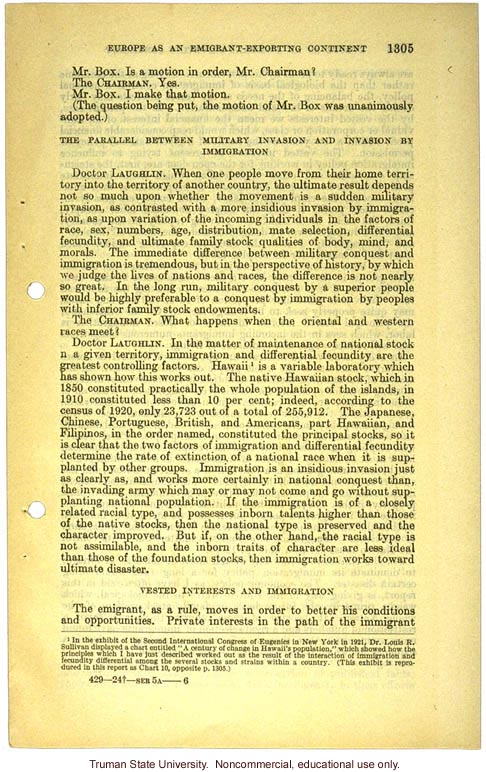Europe as an Emigrant-Exporting Continent 1305
Mr. Box. Is a motion in order, Mr. Chairman?
The Chairman. Yes.
Mr. Box. I make that motion.
(The question being put, the motion of Mr. Box was unanimously adopted.)
The Parallel Between Military Invasion and Invasion by Immigration.
Doctor Laughlin. When one people move from their home territory into the territory of another country, the ultimate result depends not so much upon whether the movement is a sudden military invasion, as contrasted with a more insidious invasion by immigration , as upon variation of the incoming individuals in the factors of race, sex, numbers, age, distribution, mate selection, differential fecundity, and ultimate family stock qualities of body, mind, and morals. The immediate difference between military conquest and immigration is tremendous, but in the perspective of history, by which we judge the lives of nations and races, the difference is not nearly so great. In the long run, military conquest by a superior people would be highly preferable to a conquest by immigration by peoples with inferior stock endowments.
The Chairman. What happens when the oriental and western races meet?
Doctor Laughlin. In the matter of maintenance of national stock in a given territory, immigration and differential fecundity are the greatest controlling factors. Hawaii[superscript 1]is a variable laboratory which has shown how this works out. The native Hawaiian stock, which in 1850 constitutes practically the whole population of the islands, in 1910 constituted less than 10 per cent; indeed, according to the census of 1920, only 23,723 out of a total of 255,912. The Japanese, Chinese, Portuguese, British, and Americans, part Hawaiian, and Filipinos, in the order named, constituted the principal stocks, so it is clear that the two factors of immigration and differential fecundity determine the rate of extinction of a national race when it is supplanted by other groups. Immigration is an insidious invasion just as clearly as, and works more certainly in national conquest than, the invading army which may or may not come and go without supplanting national population. If the immigration is of a closely related racial type, and possesses inborn talents higher than those of the native stocks, then the national type is preserved and the character improved. But if, on the other hand, the racial type is not assimilable, and the inborn traits of character are less ideal than those of the foundation stocks, then immigration work toward ultimate disaster.
Vested Interests and Immigration
The emigrant, as a rule, moves in order to better his conditions and opportunities. Private interests in the path of the immigrant
[hairline rule]
[footnote text, initiated by a superscript 1] In the exhibit of the International Congress of Eugenics in New York in 1921, Dr. Louis R. Sullivan displayed a chart entitled, "A century of change in Hawaii's population," which showed how the principles which I have just described worked out as the result of the interaction of immigration and fecundity differential among the several stocks and strains within a country. (This exhibit is reproduced in this report as Chart 10, opposite p. 1305.)
429 -- 24[dagger] - ser 5A-6


